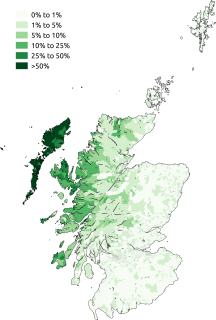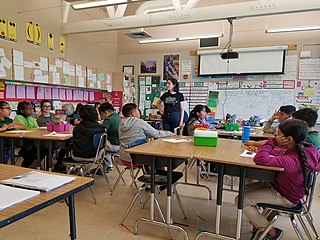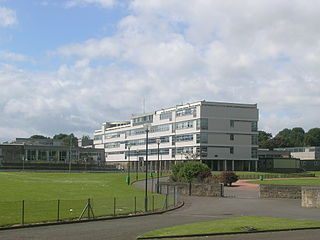
Scottish Gaelic, also known as Scots Gaelic and Gaelic, is a Goidelic language native to the Gaels of Scotland. As a Goidelic language, Scottish Gaelic, as well as both Irish and Manx, developed out of Old Irish. It became a distinct spoken language sometime in the 13th century in the Middle Irish period, although a common literary language was shared by Gaels in both Ireland and Scotland down to the 16th century. Most of modern Scotland was once Gaelic-speaking, as evidenced especially by Gaelic-language place names.

A student is primarily a person enrolled in a school or other educational institution and who is under learning with goals of acquiring knowledge, developing professions and achieving employment at desired field. In the broader sense, a student is anyone who applies themselves to the intensive intellectual engagement with some matter necessary to master it as part of some practical affair in which such mastery is basic or decisive.
In the education systems of England, Northern Ireland, Wales, Jamaica and some other Commonwealth countries, sixth form represents the 2 years of post-GCSE academic education, where students start the first academic year in the sixth form age 16 and finish age 17 and start the second academic year in the sixth form age 17 and finish age 18. During the two years they prepare for their A-level examinations. In England, Wales, and Northern Ireland, the term Key Stage 5 has the same meaning. It only refers to post-16 academic education and not to vocational education.

Gymnasium is a term in various European languages for a secondary school that prepares students for higher education at a university. It is comparable to the British English terms grammar school and sixth form college and to US English preparatory high school. Before the 20th century, the gymnasium system was a widespread feature of educational systems throughout many European countries.
A middle school is an educational stage which exists in some countries, providing education between primary school and secondary school. The concept, regulation and classification of middle schools, as well as the ages covered, vary between, and sometimes within, countries.
Education in the United Kingdom is a devolved matter with each of the countries of the United Kingdom having separate systems under separate governments: the UK Government is responsible for England; whilst the Scottish Government, the Welsh Government and the Northern Ireland Executive are responsible for Scotland, Wales and Northern Ireland, respectively.
Education in Scotland is overseen by the Scottish Government and its executive agency Education Scotland. Education in Scotland has a history of universal provision of public education, and the Scottish education system is distinctly different from those in the other countries of the United Kingdom. The Scotland Act 1998 gives the Scottish Parliament legislative control over all education matters, and the Education (Scotland) Act 1980 is the principal legislation governing education in Scotland. Traditionally, the Scottish system at secondary school level has emphasised breadth across a range of subjects, while the English, Welsh and Northern Irish systems have emphasised greater depth of education over a smaller range of subjects.
State schools or public schools are generally primary or secondary schools that educate all children without charge. They are funded in whole or in part by taxation. State funded schools exist in virtually every country of the world, though there are significant variations in their structure and educational programmes. State education generally encompasses primary and secondary education.

Fourth grade is a year of Elementary education in some countries. In North America, the fourth grade is the fifth school year of elementary school. Students are usually 9 or 10 years old, depending on their birthday, unless they started school at an earlier or later date than the average student. It can be considered a part of elementary school, traditionally providing instruction for young pupils in grades 3, 4 or 5. This can vary in different school districts; in some, fourth grade is the first or second year of intermediate school. In others, it may be the last year of elementary.
Eighth grade is the eighth post-kindergarten year of formal education in the US. The eighth grade is the ninth school year, the second/third/fourth and final year of middle school, the second and/or final year of junior high school, and comes after 7th grade. Usually, students are 13–14 years old in this stage of education. This term is not globally understood. For example, in England and Wales, the equivalent is Year 9, and in Scotland, the equivalent is S2.
Third grade is a year of primary education in many countries. It is the third school year of primary school. Students are usually 8–9 years old, depending on when their birthday occurs.
Second grade is a year of primary education in Canada and the United States. Second grade is the second grade of primary school. Children are usually aged 7–8 in this grade level.
Tenth grade or grade 10 is the tenth year of school post-kindergarten or the tenth year after the first introductory year upon entering compulsory schooling. In many parts of the world, the students are 15 or 16 years of age, depending on when their birthday occurs. The variants of 10th grade in various countries are described below.
Eleventh grade, 11th grade, junior year, or grade 11 is the eleventh, and for some countries final, grade of secondary schools. Students are typically 16–17 years of age, depending on the country and the students' birthdays.
The Ordinary Grade of the Scottish Certificate of Education is a now-discontinued qualification which was studied for as part of the Scottish secondary education system. It could be considered broadly equivalent to the old English O-Level qualification and is the predecessor to the Standard Grade.
Year 12 is an educational year group in schools in many countries including England and Wales, Northern Ireland, Australia and New Zealand. It is sometimes the twelfth year of compulsory education, or alternatively a year of post-compulsory education. It usually incorporates students aged between 16 and 18, depending on the locality. It is also known as "senior year" in parts of Australia, where it is the final year of compulsory education. Year Twelve in England and Wales, and in New Zealand, is the equivalent of Eleventh grade, junior year, or grade 11 in the US and parts of Canada.
Year Eleven is an educational year group in schools in many countries including England and Wales, Northern Ireland, Australia and New Zealand. It is the eleventh or twelfth year of core education. For some Year Eleven students it is their final year studying and may include final exams. In the US and Canada, it is referred to as tenth grade.
Year Ten is the tenth year of compulsory education in schools in many countries including England, Australia, India, Northern Ireland, New Zealand and Wales. It is the tenth or eleventh year of compulsory education. It is approximately equivalent to ninth grade, "freshman year," or "Second year" in the US, and grade nine in Canada. It is the second to last year of compulsory education.

Gracemount High School (GHS) is a non-denominational six-year comprehensive secondary school serving south-east Edinburgh, Scotland. It has a current roll of over 600 pupils and around 80 staff. It is operated by City of Edinburgh Council, the local education authority. No current inspection report is available and it was last inspected in 2013.

Secondary education in Scotland can take up to 6 years, covering ages 11 to 18, from S1 to S6. Education is not compulsory after the age of 16, the age of majority in Scots law.





